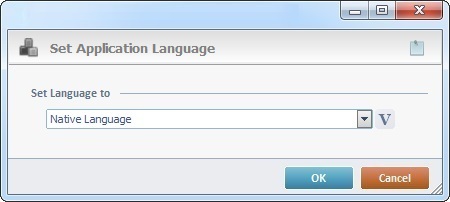Working with Set App. Language Process
Process Purpose
The "Set App. Language" is used to define the application language. The available choices refer to the previously selected languages in the "Localization" tab (project properties). See Localization.
When you add a process, you are required to define its settings. This occurs in the process's properties window which is displayed automatically after having added the "Set App. Language" process.
If any subsequent edition is required, double-click the process to open its properties window and enter the necessary modifications.

Fill in the box:
Set Language to |
Select the desired language from the drop-down OR click |
If required, click ![]() to attach any relevant notes to this process. Click it and enter your notes in the resulting text box. These notes will be displayed in the corresponding "Actions" tab or "Process" window (in the "Notes" field) and in the "Developer Report".
to attach any relevant notes to this process. Click it and enter your notes in the resulting text box. These notes will be displayed in the corresponding "Actions" tab or "Process" window (in the "Notes" field) and in the "Developer Report".
After filling in the required options, click ![]() to conclude or
to conclude or ![]() to abort the operation.
to abort the operation.
The added process is displayed in the corresponding "Actions" tab or "Process" window.
Usage Examples
Manual Implementation
Include the process into a Button control. The defined language becomes the application’s language (meaning, the current localization tags are replaced with the localization tags associated to the new language) when the operator presses the button.
Automatic Implementation
This process is included in a screen’s “routine in” – once that screen is drawn the application’s language becomes the language you defined in the “Set App Language” process.
Use of Variables
You can use variables to define the application language.
•When using a value from a “Program” or “Global” variable to set the language for the application, the only acceptable value is the commonly established language code.
Ex: To set French as the application language, the value within the variable must be "fr".
Check the table below with the acceptable language codes in MCL-Designer V4.
Language Name |
Language Code |
Albanian |
sq |
Bulgarian |
bg |
Catalan |
ca |
Chinese |
zh |
Czech |
cs |
Danish |
da |
Dutch |
nl |
English |
en |
American English |
en-us |
Great Britain English |
en-gb |
Estonian |
et |
Finnish |
fi |
French |
fr |
German |
de |
Greek |
el |
Hebrew |
he |
Hungarian |
hu |
Italian |
it |
Japanese |
ja |
Latvian |
lv |
Norwegian |
no |
Polish |
pl |
Portuguese |
pt |
Romanian |
ro |
Russian |
ru |
Spanish |
es |
Swedish |
sv |
If necessary, you can also use the value "Native Language" as a language code ("Native Language" refers to MCL-Designer's default language).
•System Variables
You can also use the following System variables:
"X_USR_Language" - this variable contains information on the language defined for the operator that has logged in on the application.
"X_MCL_Language" - this variable contains information on the language that is currently defined for the application.
![]()
Use the right-click in MCL-Designer's input boxes to access some related options as well as the general "Cut", "Copy"; "Paste"; "Search" actions (active/inactive according to the current context).
Ex: If you right-click the "Variable" input box (included in a "Conversion's" properties window), you are provided with general editing/search actions and other more specific options such as "Variable Select" (see "Variable Select"); "Variable Insert" (see "Variable Insert"); "Insert Special Character" (see To Insert Special Characters into a Control's Text Input Field) and "Localization Select" (see Localization List).
If you right-click another input box, it may provide other possibilities.
